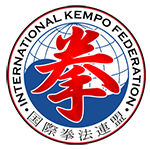KEMPO
FROM MARTIAL ARTS TO MARTIAL SPORT
KEMPO ARRIVED IN CHINA VIA INDIA

The art of Kempo, also written as Kenpo, is unique as far as its history goes in two respects; it is considered by many the first eclectic martial art, as well as having its founding roots stretch back to 520 BC. The person who was a catalyst of the way of Kempo was a prince and warrior of southern India called Bodhidharma. According to the records of the Lo-Yang temple, Bodhidharma was a Buddhist monk from India, under the tutelage of Prajnatara, and it is presumed that upon his death bed that Prajnatara requested Bodhidharma to travel to China where he felt the principles of Buddhism wherein decline, and that the knowledge of dhyana (Zen) should be known.
It is estimated that Bodhidharma entered China and traveled northward to the kingdom of Wei where the fabled meeting with emperor Wu of the Liang dynasty began. This meeting is recorded due to the intense conversation and discussion of Buddhism and dhyana which took place. The meeting was to no avail, his words to the worldly emperor meant nothing, and thus, sullied by his attempts, Bodhidharma left the palace of the emperor and traveled to the Honan province where we entered the Shaolin temple and began a martial history.
Bodhidharma’s depression grew once he reached the famed Shaolin temple for Prajnatra’s telling was true. The monks were in a raged condition physically and mentally diminished due to the excess amount of time the monks spent in meditation and little else. Many of the monks would often fall asleep in meditation while others needed assistance in the basic necessities of life – so feeble was their condition.
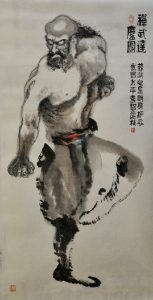 For an unknown period of time, Bodhidharma meditated in a cave at the outskirts of the temple seeking a way to renew the feat of Buddha’s light, as well as letting the monks regain control over their lives. Upon his return, Bodhidharma instructed the monks into the courtyard, from the strong to the feeble, and began to explain and work with them in the art of Shih Pa Lo Han Sho, or the 18 hands of Lo Han. These techniques which are the foundation for almost all martial arts today were never originally intended to be utilized as methods of fighting but were a manner in which the monks could attain enlightenment while preserving their body’s health. During the Sui period, approximately forty years or so after the death of Bodhidharma it is told that brigands assaulted the Shaolin monetary; one of many attacks that would occur until the early twentieth century. During this first invasion, the monk’s attempts at defending their temple were futile, their skills were not attuned to fighting techniques and it looked as if the temple would fall. A monk of the temple, with reference only as of the “begging monk”, during the last siege of the temple by the brigands attacked several of the outlaws with an array of aggressive hand and foot techniques, killing some and driving the remaining attackers away. The other monks were so inspired by the display of this single priest that they requested tutelage in this martial style as a means of protection. In later scripts, this fighting art was recorded as Chuan-Fa Kempo.
For an unknown period of time, Bodhidharma meditated in a cave at the outskirts of the temple seeking a way to renew the feat of Buddha’s light, as well as letting the monks regain control over their lives. Upon his return, Bodhidharma instructed the monks into the courtyard, from the strong to the feeble, and began to explain and work with them in the art of Shih Pa Lo Han Sho, or the 18 hands of Lo Han. These techniques which are the foundation for almost all martial arts today were never originally intended to be utilized as methods of fighting but were a manner in which the monks could attain enlightenment while preserving their body’s health. During the Sui period, approximately forty years or so after the death of Bodhidharma it is told that brigands assaulted the Shaolin monetary; one of many attacks that would occur until the early twentieth century. During this first invasion, the monk’s attempts at defending their temple were futile, their skills were not attuned to fighting techniques and it looked as if the temple would fall. A monk of the temple, with reference only as of the “begging monk”, during the last siege of the temple by the brigands attacked several of the outlaws with an array of aggressive hand and foot techniques, killing some and driving the remaining attackers away. The other monks were so inspired by the display of this single priest that they requested tutelage in this martial style as a means of protection. In later scripts, this fighting art was recorded as Chuan-Fa Kempo.
Over several decades the fighting arts of the Shaolin temple grew and were said to prosper over 400 arts in total over the next several centuries. Several decades after the fight of the begging monk, a master of Chuan Fa called Ch’ueh Taun Shang-Jen was said to have rediscovered the original Shih Pa Lo Han Sho which had been lost for many years. Church over a period of time-integrated his art of Chuan Fa with that of Lo Han increasing the total number of techniques from the original eighteen to a total of seventy-two. For several years after this period, Ch’ueh traveled the countryside of China promoting his art in several grueling fighting matches until he came upon a man named Li in the province of Shensi. Li, a master of Chuan-Fa Kempo traveled and trained with Ch’ueh for some time developing the curriculum of Chuan-Fa to form a total of one-hundred and seventy techniques. Furthermore, they categorized these techniques into five distinctive groups distinguished by various animals whose instinctive reactions best reflected the movements of this new Chuan-Fa Kempo and brought to the Shaolin temple a new stage in martial arts evolution.
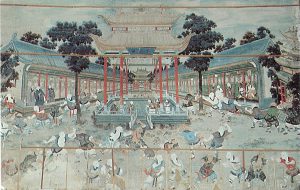 Over the next several centuries the history of Chuan-Fa and its advent to Kempo is ragged in its tales and difficult to gain accurate descriptions. What is known is that the art of Kempo remained and is still practiced in China, but its teaching also found its way to Okinawan Islands and the Ryukyu kingdoms as well as Japan. In both places, the art was referred to as Kempo.
Over the next several centuries the history of Chuan-Fa and its advent to Kempo is ragged in its tales and difficult to gain accurate descriptions. What is known is that the art of Kempo remained and is still practiced in China, but its teaching also found its way to Okinawan Islands and the Ryukyu kingdoms as well as Japan. In both places, the art was referred to as Kempo.
Between the Sui and Ming periods (an 800-year gap) it is considered that many a wandering monk traveled across Japan and Okinawa bringing with them a working knowledge of the art of Kempo which explains its wide-spread distribution. The art of Chuan Fa which translates into Kempo would have been taught as a supplement to the daily spiritual training the monks endured. Many of the monks would often choose disciples or teach at various Buddhist temples bringing the word of Buddha and the power of Kempo as well.
From there the art of Kempo could easily spread among the commoners and nobles alike.
OKINAWA KENPO – 1900
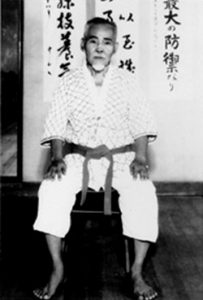 An early reference to the term “Okinawa Kenpo” dates back to beginnings of the 20th century. During this period, the Kenpo/Kempo name was used as a generic name for all Okinawan fighting methods. It was not until the early 1950’s that the use of the name shifted to describe a particular system taught by Master Shigeru Nakamura.
An early reference to the term “Okinawa Kenpo” dates back to beginnings of the 20th century. During this period, the Kenpo/Kempo name was used as a generic name for all Okinawan fighting methods. It was not until the early 1950’s that the use of the name shifted to describe a particular system taught by Master Shigeru Nakamura.
In 1955, the “Okinawa Kenpo Renmei” was formed by Masters Shigeru Nakamura and Zenryo Shimabuku, with Master Nakamura as President.
After Master Nakamura’s death in 1969, the Okinawa Kenpo Renmei appointed SEIKICHI ODO as Master of Okinawa Kenpo and also as President of the All Okinawa Kenpo Karate-do League. Shortly afterward, Master Seikichi Odo officially added the weapons to Okinawa Kenpo.
Many of the Okinawan martial arts groups use the term kenpō as an alternate name for their systems. This can be illustrated by the official full name of the Motobu-Ryu style named as “Nihon Denryu Heiho Motobu Kenpo”. Both the “n” and “m” romanizations are used by various groups, both of them being correct.
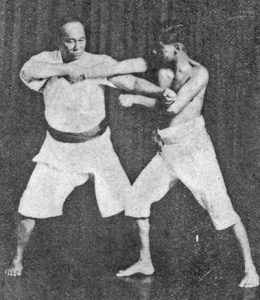
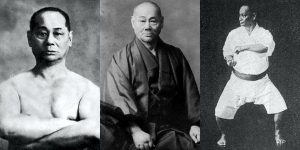
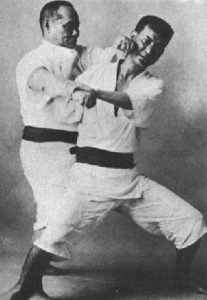
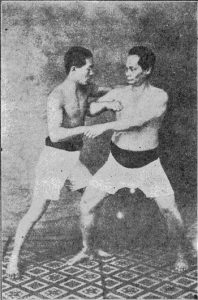
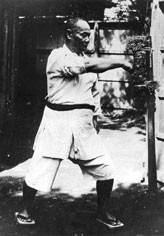
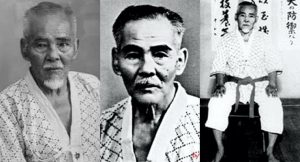
NIPPON KEMPO – 1932
 Nippon Kempo means Japanese Kempo, it can refer to any kind of Kempo from Japan, but in modern times it is normally used to refer to the popular style of sporting Kempo founded by Master Sawayama Muneomi. Nippon Kempo was not established and promoted as a martial art in the meaning of self-defense. Nippon Kempo was created as a sport, having very clear sport rules and regulations, practiced wearing protective gear (face, body, crotch, etc.) and gloves. Practically, Nippon Kempo can be considered the first modern mixed martial combat full-contact sport using stand-up striking, throwing, and ground fighting.
Nippon Kempo means Japanese Kempo, it can refer to any kind of Kempo from Japan, but in modern times it is normally used to refer to the popular style of sporting Kempo founded by Master Sawayama Muneomi. Nippon Kempo was not established and promoted as a martial art in the meaning of self-defense. Nippon Kempo was created as a sport, having very clear sport rules and regulations, practiced wearing protective gear (face, body, crotch, etc.) and gloves. Practically, Nippon Kempo can be considered the first modern mixed martial combat full-contact sport using stand-up striking, throwing, and ground fighting.
Nippon Kempo was one of the first modern martial arts to establish the form of sport free-fighting and being practiced in protective gear.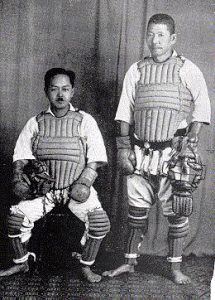
Nippon Kempo places an equal emphasis on striking techniques using hands and feet, immobilization and controls, projections, and takedowns.
From a technical point of view, Nippon Kempo is a mixed martial art system based on techniques of striking and kicking, (atemi-waza), blocking (uke-waza), throwing (nage-waza), reverse joint locks (kansetsu-gyakutori-waza) and ground combat (ne-waza).
Practitioners fight and practice these techniques with protective gear, as the art is full-contact and therefore men (helmet), do (breastplate), kurobu (gloves), and a mata ate (groin protector) are used. Grabbing a strike or locking a joint is allowed, as are knees and elbows to the body or to the face score points. As “headhunting”, the practice of trying to score quickly with a punch to the head is common, practitioners aim to learn and develop head and body movements to avoid, deflect or counter many punching and kicking combinations.
Since its inception, Nippon Kempo has a long history of direct striking and making full use of various other techniques, long before the mixed martial arts movement as it is known today. Nippon Kempo was one of the first Japanese martial arts to allow punches to the head.
Exchanges with other schools is also active. Since 2005, the professional mixed martial arts show “HEAT” has been held regularly at Nippon Kempo Dojo at Concentric Hall in Nagoya. Practitioners of Nippon Kempo have fought in the Hokutoki Tournaments hosted by Daido juku, which features a martial art similar to Nippon Kempo known today as Kudo. Yasushi Tsujii (Kenpokai), Takayuki Sato (Kenpokai), Katsushi Okazaki (Aoba Kenpokai), Toru Saito (Nippon Kempo Azusakai), Shinya Yamauchi (Aoba Kenyukai), and other Nippon Kempo players have participated, and have won top prizes and awards.
SHORINJI KEMPO – 1947
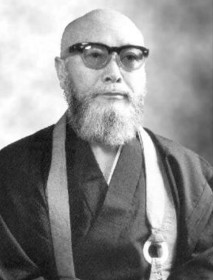 Shorinji Kempo is the Japanese translation of Chinese Shaolin Kempo. Doshin Sō was born in Okayama prefecture and spent his youth in northern China, first with his grandfather and then as an intelligence agent of the
Shorinji Kempo is the Japanese translation of Chinese Shaolin Kempo. Doshin Sō was born in Okayama prefecture and spent his youth in northern China, first with his grandfather and then as an intelligence agent of the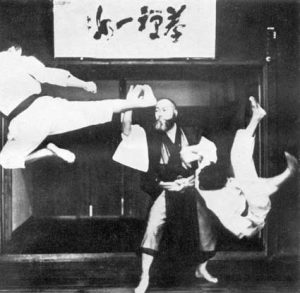 occupying Imperial Japanese Army to collect military information during the war. As part of his cover, he was posted to a Taoist school as an apprentice. There, Nakano met Chen Lian, a Taoist priest and master of Báilián Quán (“White Lotus Fist”). After a while, Chen introduced Nakano to Wen Taizong, a master in Yihe Quán (“Righteous Harmony Fist”). Wen would take in Nakano as his student at the Shaolin Temple, at Henan, and passed onto him the title of grandmaster in that specific style of Quan-Fa.
occupying Imperial Japanese Army to collect military information during the war. As part of his cover, he was posted to a Taoist school as an apprentice. There, Nakano met Chen Lian, a Taoist priest and master of Báilián Quán (“White Lotus Fist”). After a while, Chen introduced Nakano to Wen Taizong, a master in Yihe Quán (“Righteous Harmony Fist”). Wen would take in Nakano as his student at the Shaolin Temple, at Henan, and passed onto him the title of grandmaster in that specific style of Quan-Fa.
In the final days of the Second World War, the Soviet Union broke its neutrality pact with Japan, declaring war. The Soviets invaded Manchuria on 9 August and overran the Japanese in less than 11 days. The aftermath was appalling; Japanese casualties were tenfold than that of the Soviets’; both civilians and wounded Japanese soldiers were left to die while the army retreated, and many Japanese civilians committed mass suicide. It was in this carnage that Dōshin Sō recognized and understood the “nature of the human being”. According to his book, the nature and quality of the person are extremely important since politics, law, and day-to-day living are all conducted by human beings.
After returning to Japan, Doshin Sō thought of establishing a cram school for young people. He was stationed in the small town of Tadotsu, on Shikoku island, to teach Buddhist philosophy. He established Shorinji Kempo to take the concept of ken-zen ichinyo by following Bodhidharma and made use of techniques he had learned in China. This promotion and campaign was known as Kongō-zen undō (Diamond-zen campaign) and expanded Shorinji Kempo throughout Japan by his pupils. This campaign and concept were inherited by his daughter Yūki Sō after his death in 1980 till the present. After his death, Dōshin Sō is called “Kaiso” or Founder.
AMERICAN KENPO – 1956
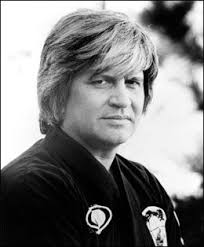 American Kenpo is an updated system of martial arts based on modern-day street fighting that applies logic and practicality. It is characterized by the use of quick and powerful strikes delivered from all of the body’s
American Kenpo is an updated system of martial arts based on modern-day street fighting that applies logic and practicality. It is characterized by the use of quick and powerful strikes delivered from all of the body’s 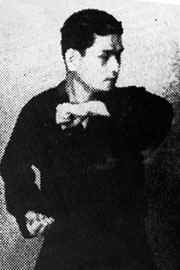 natural weapons, powered by rapid stance transitions, called “shifting.” Beginners are introduced to basic attack responses, which comprise a larger system taught through scripted scenarios, which allow instructors a platform to share concepts and principles Ed Parker emphasized in his teachings.
natural weapons, powered by rapid stance transitions, called “shifting.” Beginners are introduced to basic attack responses, which comprise a larger system taught through scripted scenarios, which allow instructors a platform to share concepts and principles Ed Parker emphasized in his teachings.
The purpose of training in this manner is to increase physical coordination and continuity with a linear and circular motion. Each movement, when correctly executed, leads into the next, keeping an adversary’s “dimensional zone” in check while limiting their ability to retaliate. Should the adversary not react as anticipated, the skilled Kenpo practitioner, it is argued, is able to seamlessly transition into an alternative and appropriate action, drawn spontaneously from the trained subconscious.
Founded and codified by Ed Parker, American Kenpo is primarily a self-defense combat system. Parker made significant modifications to the original art of Kenpo which he learned throughout his life, by introducing or changing principles, theories, and concepts of motion, as well as terminology. Parker believed in tailoring Kenpo to the individual and would also encourage his students to explore the unknown areas of martial arts.
Parker left behind a large following of instructors who honored his teachings by implementing many different versions of American Kenpo. As Senior Grandmaster, Parker did not name a successor to his art but instead entrusted his senior students to continue his teachings in their own way.
The modern history of American Kenpo began in the 1940s, with James Mitose (1916–1981). Mitose was only one of the many people that Ed Parker’s Kenpo Instructor William K. S. Chow worked with. William K. S. Chow, aka Professor Chow, aka Thunderbolt Chow. Professor Chow and his teacher, Thomas Young, handled much of the teaching of the Martial Arts and James Mitose advertised the club and set up demonstrations. 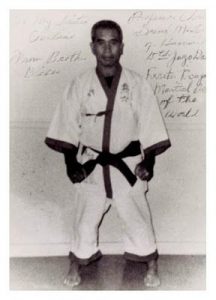 However, Professor Chow thought of Mitose as “a con-artist who was all talk” and went off to teach on his own. Mitose was never a teacher of Ed Parker and thus had no part in American Kenpo.
However, Professor Chow thought of Mitose as “a con-artist who was all talk” and went off to teach on his own. Mitose was never a teacher of Ed Parker and thus had no part in American Kenpo.
William Chow claimed to have studied multiple Martial Arts in Hawaii, including Chinese Kung Fu (Shaolin) from his father. Chow eventually developed Kenpo Karate, which had a blend of linear and circular motion, and emphasized practical fighting techniques designed to outperform the various martial arts in the melting pot of Hawaii. Chow experimented and modified his art, adapting it to meet the needs of American students.
The legendary Ed Parker, dubbed “The Magician of Motion”, started his martial arts training in Judo, earning a black belt. He then studied western boxing from his father, a boxing commissioner in Hawaii, before eventually training and earning a black belt from William Chow in Kenpo. After Ed Parker moved to California, he cross-referenced his martial arts knowledge with Chinese martial arts masters in China. Parker hosted a large martial arts tournament, the Long Beach Internationals, where he used his analytical mind to study the attending martial artists and improved his own system, eventually founding American Kenpo. Ed Parker founded his own Kenpo association, The International Kenpo Karate Association (IKKA) after his students started teaching his art in other countries. Al Tracy claims that Chow promoted Parker to sandan (3rd-degree black belt) in December 1961.
SHAOLIN KEMPO – 1962
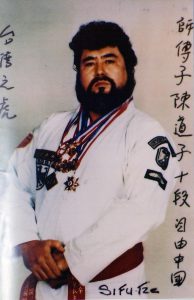 The key figure of Shaolin Kempo is the Prince of Mongolia, Dschero Khan.
The key figure of Shaolin Kempo is the Prince of Mongolia, Dschero Khan.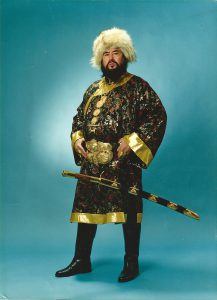
Shaolin Kempo is a martial art of Chinese origin that has been influenced by various Japanese systems. Shaolin Kempo, as practiced in Germany and the Netherlands, was founded by the Dutch Carl Faulhaber and Dschero Khan. The first Shaolin Kempo school has been founded in 1962. From this moment on, Shaolin Kempo spread first in the Netherlands and in 1967 in Germany. The name “Shaolin” is based on the northern Chinese fighting style Chuan Su. The term “Kempo” was intended to express the strong influence of the philosophical and meditative aspects.
In the practice of Shaolin Kempo kicks, punches, kicks, and simple lever and throwing techniques are used. These are practiced in the form of kata and kumite , and there are also forms of free practice. Another important training content of Shaolin Kempo is self-defense. While beginners value a sensible, effective, and situation-appropriate selection of simple self-defense techniques, advanced learners need a balance between lever, throwing, fist, and foot techniques.
The aim of the training is the harmonious interplay of mental and physical aspects. At the same time, the practitioners are given the opportunity to explore some of their own limits.
In addition, Shaolin Kempo as a martial art should make a contribution to the spiritual development of people. This means that skills such as responsibility, a positive attitude towards life and other people, or openness and honesty should be learned.
SHORINJI TORAKEN RYU KEMPO
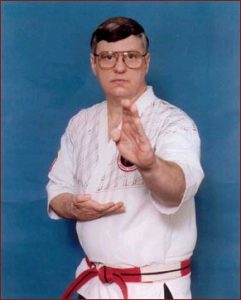
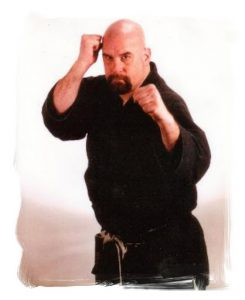 Soji Yang, a warlord, was the founder of this discipline. The long staff, fist, and foot techniques were the basis of his personal system of fighting.
Soji Yang, a warlord, was the founder of this discipline. The long staff, fist, and foot techniques were the basis of his personal system of fighting.
The Soji instructed the style in a “closed dojo”, retaining the aiki jutsu, fist, and foot forms. The name, now Shorinji Tetsu Kempo, reflected the fact that it was a composite system.
Back to 1967, after the reunion of master Kooh C. Kim and his student Albert C. Church, an American Serviceman with an extensive martial arts background, it was set the stage for the American connection to the ancient oriental martial art of Shorinji Tetsu Kempo.
In 1970, Master Church organized the Nippon Kobudo Rengokai USA. Then in 1971 Kamishin Ryu, the son art of Shorinji Tetsu Kempo was used by all Nippon Kobudo Rengokai USA schools in America and Japan to confer kyu and dan grades.
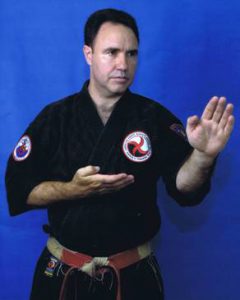 Dr. James Ronald Cherry was the chief instructor and examiner for Soke Church in all aspects of Soke Church’s arts from 1975 to 1980. In 1980 Soke Church, unfortunately, passed away. After the death of Soke Church, Dr. Cherry formed the American Kempo-Karate Association and founded the system known as Shorinji Toraken Do Kempo, as composite art.
Dr. James Ronald Cherry was the chief instructor and examiner for Soke Church in all aspects of Soke Church’s arts from 1975 to 1980. In 1980 Soke Church, unfortunately, passed away. After the death of Soke Church, Dr. Cherry formed the American Kempo-Karate Association and founded the system known as Shorinji Toraken Do Kempo, as composite art.
In 1982-1985, Cherry was a civilian contractor teaching counter-terrorism and SWAT training at Fort Gordon, GA. and Bureau Public Service Institute, where law enforcement and military tactical teams come for training from all over the world. He has trained numerous government and law enforcement personnel in Unconventional Personal Combat (UPC), weapons, executive protection, and counter-terrorism techniques.
On March 18, 2000, Dr. Cherry performed an Inheritor/successorship ceremony transferring the leadership of Shorinji Toraken Ryu Kempo Arts and the American Kempo-Karate Association to his personal student since 1983, Master Ray Ferrell.
Another very important representative of AKKA Kempo inside of the International Kempo Federation is Master Robert Zingg.
ZEN BU KAN KEMPO
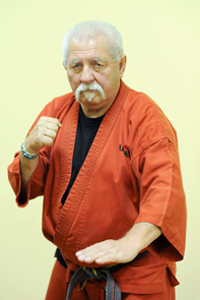 Zen Bu Kan Kempo was founded by Hanshi Imre Harnos, one of the most respected grandmasters in Hungary.
Zen Bu Kan Kempo was founded by Hanshi Imre Harnos, one of the most respected grandmasters in Hungary.
Zen Bu Kan Kempo includes both bare-handed and armed basic techniques. Is a very complex Kempo fighting style based on a combination of punches, kicks, throws, strains, strangles. It features a traditional boxing school, practicing the use of the knee and elbow. Ground fighting is also allowed for the oppressor. The style places great emphasis on teaching life-like “street” self-defense. Competitors use a batting protector, fighting barefoot in boxing gloves with a bandage underneath.
It contains a set of all the techniques that can be applied in a real combat and self-defense situation, the main principle being efficiency and reality. Training is fight-centric (punch-kick, throw-fight, ground combat), but it also includes teaching form exercises and the use of weapons to promote individual development.
Following the traditional line, the competitive sport line includes divisions and rules in which you can compete in bare-handed and armed form practice. The third technical competition is bare-handed self-defense, where the goal is to demonstrate an effective solution to life-like street offensive situations.
In ZenBuKan Kempo, the combat sport competitions can be categorized according to the number of techniques used and their strength as follows:
- No-gi ground fight: takes place in a body-fitting suit. Free grappling is a system of rules that can end with scoring or a task (knocking).
- Gi groundfight: competitors wear Kempo clothes (gi). Free grappling is a system of rules that can end with scoring or a task (knocking).
- Fight-B class: competitors wear Kempo clothes (gi). 10-ounce boxing gloves are required. Half force punch and kick are allowed on the head, full force punch and kick (including knee kick) on a regular body. Throwing and ground fighting is allowed. Hitting and kicking during ground combat is prohibited.
- Bare-handed Fight: wear body-fitting clothing. Gloveless, bare-handed race. Full force circular kick and knee kick are allowed on the head, head beating is prohibited, full force blow and kick (including knee kick) on a regular body. Throwing and ground fighting is allowed. Full force punches and kicks are allowed during ground combat.
- Fight-A class:: takes place in a fitting suit. 10-ounce boxing gloves are required. You can attack your head and body with a full-force punch and kick (including knee kick). Throwing and ground fighting is allowed. Full force punches and kicks are allowed during ground combat.
- Battle-MMA Fight: Competitors wear body-fitting clothing. Wearing 7 ounce MMA gloves is mandatory. Full force punching and kicking is allowed on the head and body. Throwing and ground fighting is allowed. During ground combat, full force punches and kicks to the head and body are allowed.
KENPO 5.0
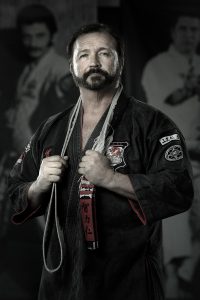 Founded by Jeff Speakman as a very complex, modern, and attractive martial art and martial sport as well. The sport fighting rules are included in the mix-fight way of fighting, using the whole arsenal of kicks, punches,
Founded by Jeff Speakman as a very complex, modern, and attractive martial art and martial sport as well. The sport fighting rules are included in the mix-fight way of fighting, using the whole arsenal of kicks, punches, 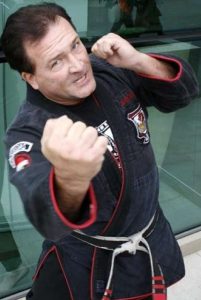 elbows, throws, and ground fighting.
elbows, throws, and ground fighting.
American Kenpo version 5.0 is the hybrid of the last generation version of American Kenpo taught directly from Senior Grand Master Ed Parker to Jeff Speakman and ground fighting brought into the equation by Mr. Speakman.
Mr. Speakman creates Kenpo answers to defending against an opponent with these skills in the street.
Kenpo 5.0 remains completely within the combat models and thinking of American Kenpo to address this increasing and prevalent void in the Kenpo world.
Kenpo 5.0 organizes continental and world championships where hundreds of athletes from around the globe participate in.
FULL-CONTACT KEMPO (MIX-FIGHT KEMPO)
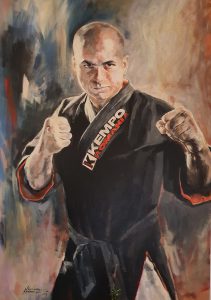 This powerful fighting method was developed during ‘80s by Master Amatto Zaharia, who created his organization underground at that time, as long as practicing martial arts during communism was illegal. Amatto Zaharia practiced boxing, judo, and karate, combining them in one fighting style being his best choice.
This powerful fighting method was developed during ‘80s by Master Amatto Zaharia, who created his organization underground at that time, as long as practicing martial arts during communism was illegal. Amatto Zaharia practiced boxing, judo, and karate, combining them in one fighting style being his best choice.
Amatto Zaharia is a multiple European and world champion but also a military expert, being one of the top instructors of the Romanian commando troops and an elite sniper also. In 2009, for his merits in promoting and developing the combat sport of Kempo worldwide, he was awarded by His Excellency Traian Basescu, the President of Romania.
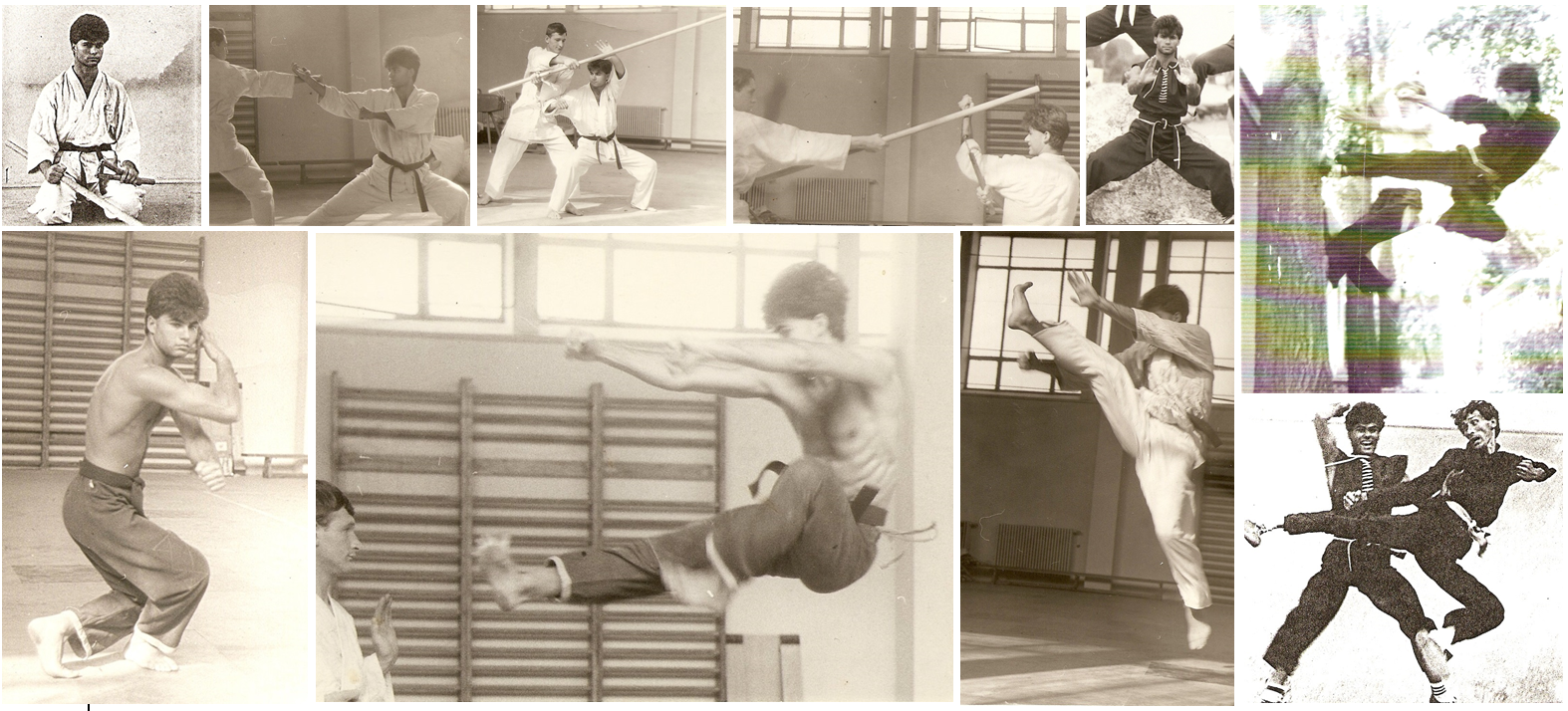
But more than this, Amatto Zaharia was a visionary who pioneered the idea of bringing Kempo under the same umbrella for getting more and more recognition internationally as an official sport. At the end of the 20th century, based on long-time experience and connections in the world of Kempo, Amatto Zaharia started to contact different masters and Kempo styles/organizations, putting them at the same table, bringing to the same point the different rules of competition, uniformizing also the clothes of the referees and athletes. In this way, after many years of hard work and dedication, the International Kempo Federation appeared.
 At present, Amatto Zaharia is an Executive-Member of the Romanian Olympic Committee and also the Executive-President of the International Kempo Federation.
At present, Amatto Zaharia is an Executive-Member of the Romanian Olympic Committee and also the Executive-President of the International Kempo Federation.
CONCLUSIONS
Kempo is a unique martial art having been founded several centuries ago in the Chinese Shaolin temple, thus bringing with it a certain air of mystery. As a martial art, Kempo is referred to as a Do. The Do is referred to in Buddhist Zen scripts as a path towards enlightenment. Lao Tzu, a priest of Taoism said “Mastering others requires force; Mastering the self requires enlightenment..” This phrase sums up the full circle of what Kempo strives towards. Although on its surface Kempo can be seen as a unique form of self-defense, hidden beneath its physical exterior are levels where characteristic centralization of mind and body form. At this level, Kempo’s practitioners up from a simple form of fighting to a higher level of ability – a level of enlightenment. Ying Kuchan, a Shaolin monk and master of Kempo after a lengthy period of meditation in a Zen rock garden spoke of Kempo saying “Kempo is the power of adaptability and yielding; the harmony of all things working together.”
On the surface, Kempo’s uniqueness lies in its comprehensive and diversified means of unarmed defense. Kempo is both an armed and unarmed system of combat incorporating applications in varying appearances and methods. On an external level, Kempo is a no holds barred fighting system of offensive and defensive methods with equal emphasis of striking techniques with the hands and feet; immobilization and controls; projections and takedowns; as well as weaponry and various spiritual and healing arts. Kempo is a street wise defensive art that does not restrict its students in methodology. Clawing hands evolve into slashing feet. Cunning joint locks turn into devastating hip throws. Evasive blocks turn into breath closing chokes.
The possibilities are endless. The only true fighting systems are those where there are no rules applied. From the books of the Han dynasty, we learn “Nothing is impossible to a willing mind.” Kempo tries to build a person’s psychological persona as well as turning the ego-self into the egoless self. The true Kempo is not a means of felling an opponent by force of hand or weapon, nor was it originally intended as a means of arms. Kempo calls for a bringing of inner peace to the self and the universe around us.
A master of Kempo is not only a master of self-defense but a master of himself. In the end, the direction of Kempo was best described by Bruce Lee: “To have no way as a way; To have no limitations as a limitation.”
From here to there, after a road of hundreds of years from a martial art to martial sport, Kempo and its other forms take many twists and turns, constantly evolving into new states of being.
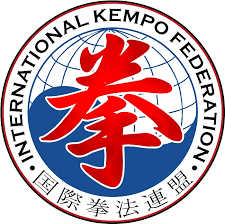
INTERNATIONAL KEMPO FEDERATION
